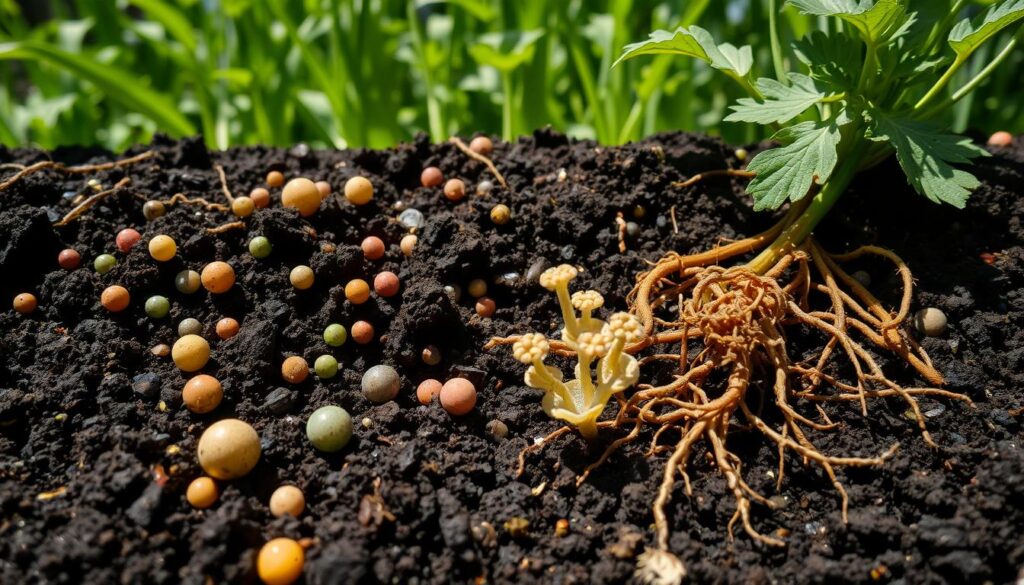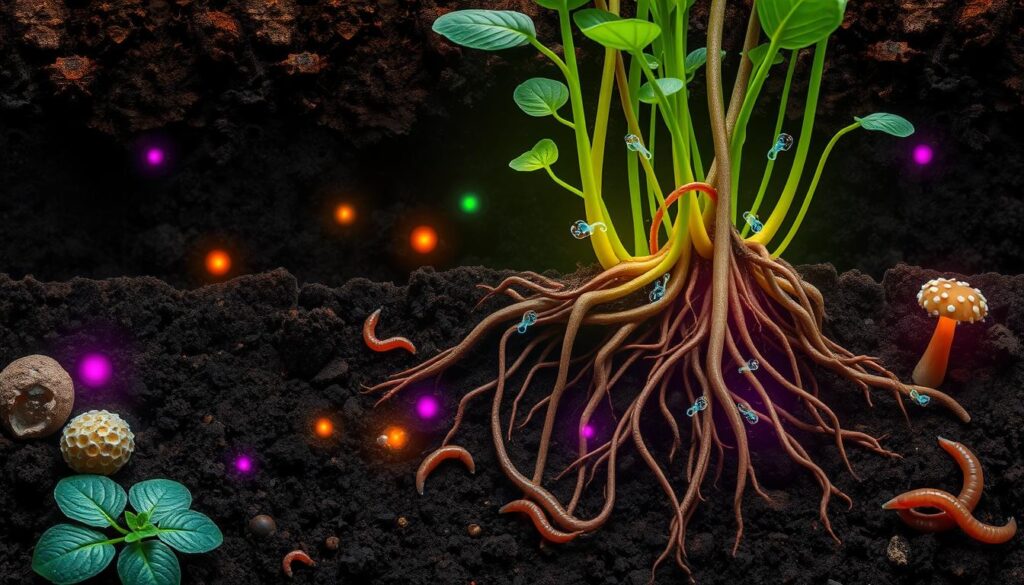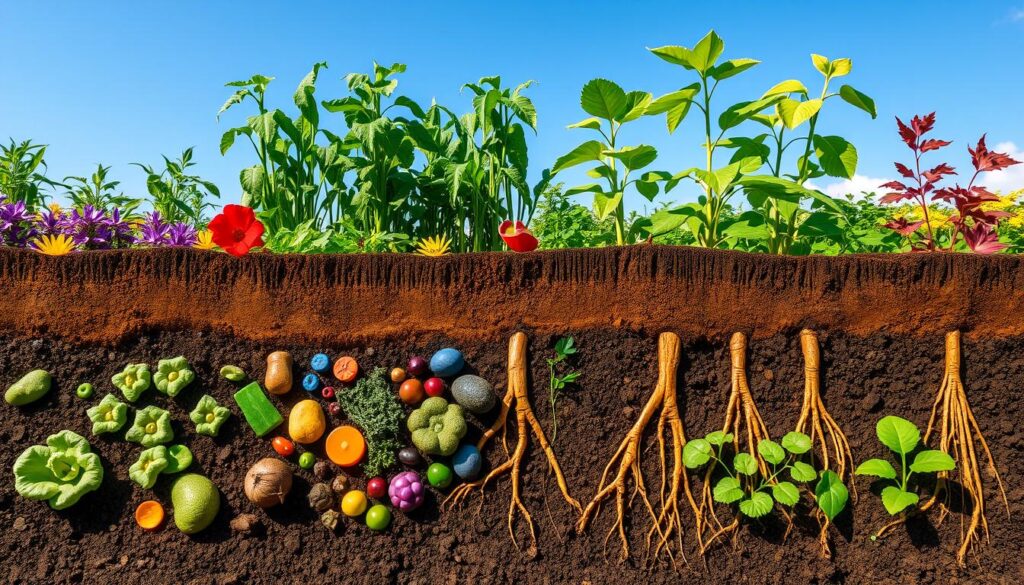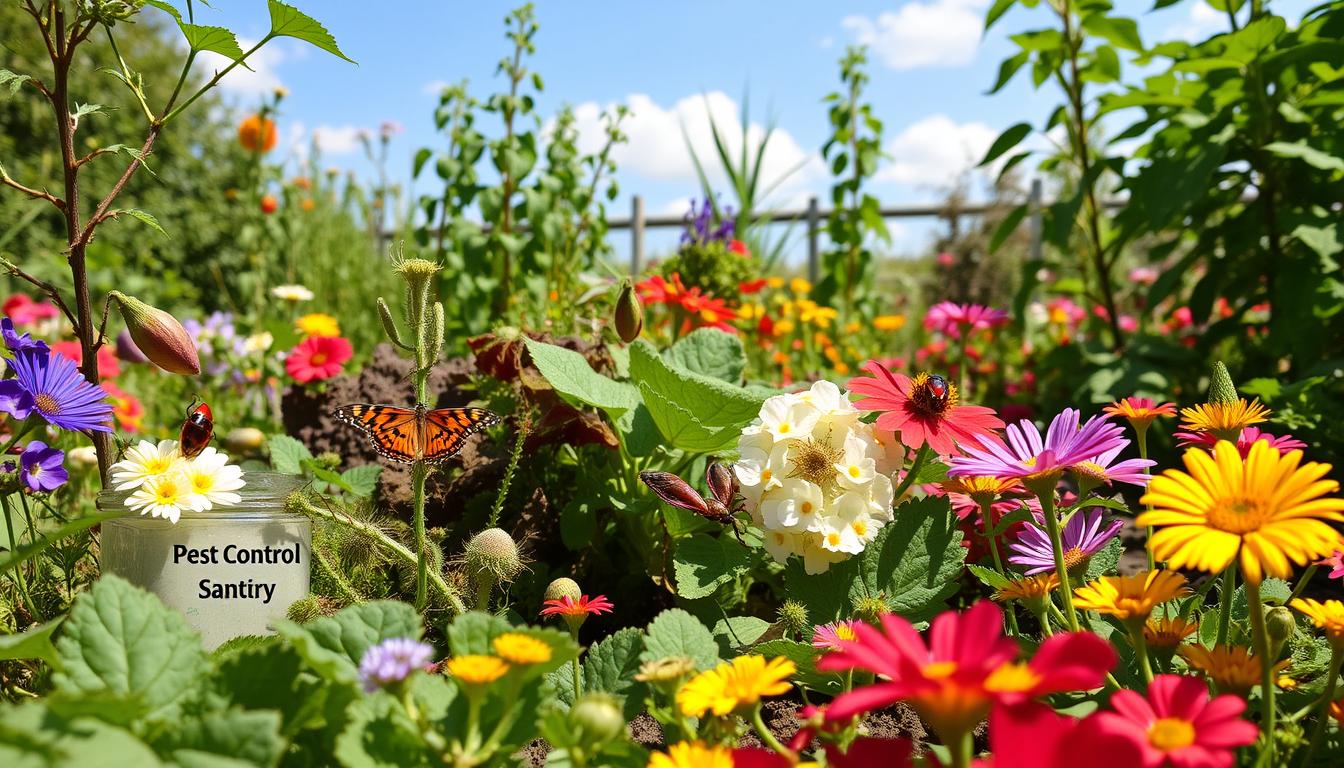Did you know nearly 70 percent of newborns carry the bacterium Clostridium difficile? This organism can cause severe chronic diarrhea in some. It shows how complex bacteria are in our gut and garden soil. A huge community of soil microorganisms lives beneath our feet, crucial for soil health.
In gardening, the fight between good and bad bacteria is key for a healthy garden. Good bacteria help soil by fixing nitrogen and making phosphorus easier for plants to use. Bad bacteria can harm plants, causing diseases. Knowing how to balance these microbes is vital for a strong garden.

Key Takeaways
- The presence of good and bad bacteria significantly impacts soil health and plant growth.
- Beneficial soil microorganisms are vital for nutrient acquisition in plants.
- Harmful bacteria can lead to diseases that threaten garden vitality.
- Understanding microbial balance is crucial for effective garden management.
- Soil health relies on a diverse community of microorganisms working synergistically.
The Importance of Soil Microorganisms
Soil microorganisms are key to keeping soil healthy. Beneficial bacteria help by breaking down nutrients and improving soil texture. The complex relationships in the soil microbiome support many ecological functions. Understanding their role is crucial for a strong agricultural ecosystem.
Role of Bacteria in Soil Health
Bacteria are vital for soil health. They break down organic matter, adding nutrients to the soil. This makes it easier for plants to get the nutrients they need to grow.
Beneficial bacteria make enzymes and acids. These help break down tough compounds like nitrogen and phosphorus. Without them, plants would find it hard to get the nutrients they need.
Microbial Diversity and Its Benefits
Soil microbiome diversity is essential for a strong ecosystem. A diverse group of microbes helps the soil resist stress and diseases. This leads to a more balanced environment.
Studies show that diverse soils can fight off harmful pathogens. This is because they have microbes that compete with or attack these pathogens.
- A diverse microbial community leads to better nutrient availability.
- Higher levels of biodiversity enhance the soil’s ability to resist and recover from disturbances.
- Microbial diversity contributes to ecological resilience in the face of climate change and agricultural practices.
Understanding the Microbial War: Good vs. Bad Bacteria in Your Soil
Soil has a delicate balance between good and bad bacteria. Knowing the difference is key to healthy plants. These microbes play different roles in soil health.
Characteristics of Beneficial Bacteria
Beneficial microbes, like Pseudomonas, help plants grow strong. They help plants absorb nutrients and fight off diseases. These good guys love rich soil, making it better for plants.
They make soil more fertile and help crops grow better.
Harmful Bacteria and Their Effects
On the other hand, harmful bacteria harm plants. They cause diseases that slow growth and lower yields. Knowing about these bad guys helps gardeners keep their soil healthy.
By spotting harmful bacteria, gardeners can fight them. This helps keep the soil balanced and healthy.
Soil Microbial Activity: The Battleground
Soil microbial activity is key to a healthy garden ecosystem. Bacteria and fungi work together to keep the soil balanced. This balance is crucial for the health of both the soil and the plants that grow in it.
Interactions Between Soil Microorganisms
Soil microorganisms live in complex communities. These communities help each other survive and thrive. For example, beneficial bacteria team up with fungi to break down organic matter. This process releases nutrients that plants need to grow.
These interactions show why it’s important to have a balanced microbial community in the soil.
Impact of Soil Microbial Balance on Plant Growth
A balanced soil microbiome is essential for plant growth. When this balance is disrupted, plants can become more vulnerable to diseases. Practices like monocropping can upset this balance, harming plant health over time.
Understanding how soil microbes work can help gardeners improve their soil. This, in turn, benefits their crops.
| Factor | Effect on Microbial Activity | Impact on Plant Growth |
|---|---|---|
| Soil Type | Affects types of microbial populations in soil | influences nutrient availability> |
| Crop Rotation | Promotes diversity in microbial communities | Enhances soil health and resilience |
| Pesticide Use | Reduces beneficial microbial populations | Increases disease susceptibility in plants |
| Organic Matter | Supports diverse microbial habitats | Improves nutrient cycling for plants |
By understanding soil microbial interactions, gardeners can improve plant health. This knowledge helps gardeners adopt practices that boost soil microbial activity. This, in turn, reduces disease risk and promotes healthier plants.
Enhancing Beneficial Soil Bacteria
Improving beneficial soil bacteria is key to better soil health. Eco-friendly practices help gardeners create a rich microbial environment. This environment supports crops and plants well.
There are many ways to boost beneficial bacteria. These methods show how important it is to have a diverse group of microbes in the soil.
Utilizing Compost for Soil Health
Composting is a great way to make soil better. It adds important nutrients and beneficial bacteria. Compost also helps soil hold water and nutrients better.
The good bacteria in compost boost soil’s microbial diversity. This diversity helps plants grow strong and healthy. It also helps them fight off environmental stress.
Cultivating Microbial Resilience
To keep soil bacteria healthy, we need to build microbial resilience. Gardeners can do this by:
- Rotating crops to avoid disease and support different microbes.
- Using cover crops to add organic matter and help beneficial microbes.
- Reducing soil disturbance to keep microbes safe and thriving.
These actions help the soil’s microbial diversity grow. This leads to healthier plants and better crops. A balanced ecosystem is crucial for sustainable gardening.

Challenges Posed by Harmful Soil Bacteria
It’s key to grasp the issues caused by harmful bacteria for healthy soil and good crops. These microbes can cause diseases that harm plants and upset the garden’s balance.
Common Soil-Borne Diseases
Harmful bacteria cause big problems for crops, leading to:
- Pythium root rot – This disease harms plant roots, especially in too much water.
- Verticillium wilt – It makes leaves wilt and plants grow slow. It stays in soil for years, making it tough to manage.
- Fusarium wilt – This disease turns leaves yellow and wilted, hurting crops like tomatoes and melons. It can cut down yields if not treated.
It’s crucial to fight these diseases since they thrive in soil always used for crops. This creates a tough cycle to break.
Management Strategies for Soil Pathogens
To tackle harmful bacteria, several strategies can be used:
- Crop rotation – Changing what crops are grown can stop harmful bacteria’s life cycle and lower disease.
- Soil testing – Testing soil regularly helps find pathogens and suggests what to add to improve it.
- Use of disease-resistant varieties – Growing plants that resist certain diseases makes gardens more resilient against harmful bacteria.
Using these methods can lessen the harm from harmful bacteria. It also makes gardens more productive.
Crop Rotation and Soil Microbial Community Dynamics
Crop rotation is key in sustainable farming, boosting soil health. By changing crops, gardeners and farmers improve soil microbes. This stops bad bacteria and helps good ones grow.
Benefits of Crop Rotation Practices
Crop rotation offers many benefits. It:
- Reduces pests by breaking their life cycles.
- Boosts soil fertility with different nutrients.
- Keeps soil structure and prevents erosion.
- Improves plant health and yield.
These benefits are crucial for managing soil health and increasing farm productivity over time.
Impact on Soil Microbial Diversity
Crop rotation increases soil microbial diversity. This is vital for a healthy soil ecosystem. Different plants support different microbes, creating a balanced community.
- Increases nutrient availability for plants.
- Encourages beneficial microbial interactions.
- Boosts soil’s ability to resist diseases and stress.
Studies show that diverse soil microbes are essential for sustainable farming. They create an environment where beneficial microbes thrive, improving crop yields.

| Crop | Microbial Impact | Nutrient Requirement |
|---|---|---|
| Corn | Supports nitrogen-fixing bacteria | High nitrogen requirement |
| Legumes | Boosts microbial diversity and activity | Fix nitrogen in soil |
| Barley | Enhances soil structure and health | Medium nutrient requirement |
| Sunflowers | Promotes root-feeding microbes | High potassium and phosphorus requirement |
Natural Soil Bacteria Management Techniques
Managing soil bacteria is key to a healthy garden. Natural methods help control harmful bacteria and boost good ones. Techniques like solarization and disinfecting tools are crucial for a balanced soil ecosystem.
Using Solarization to Clean the Soil
Solarization uses the sun’s heat to kill off bad bacteria in the soil. It involves covering moist soil with clear plastic for weeks. This method raises the soil’s temperature, killing off pathogens.
This method not only gets rid of harmful bacteria but also helps good bacteria grow. Good bacteria are important for soil health and plant growth. Farmers see better crops and less need for chemicals when they use solarization.
Disinfecting Tools and Containers to Prevent Disease
Keeping tools and containers clean is essential to stop disease spread. Bacteria can move from plant to plant and soil through equipment. Regular cleaning of tools can greatly lower disease risk.
- Bleach solutions: A mix of water and bleach can kill pathogens on tools.
- 70% alcohol: A fast-drying disinfectant that kills most bacteria and viruses.
- Vinegar: A natural option for a milder disinfectant, but less strong than bleach or alcohol.
Adding these practices to your routine helps manage soil bacteria naturally. It creates a healthier environment for plants to grow. By using solarization and disinfecting tools, gardeners can support a thriving ecosystem.
| Technique | Description | Benefits |
|---|---|---|
| Solarization | Covering soil with clear plastic to trap heat | Reduces pathogens, improves beneficial bacteria |
| Tool Disinfection | Cleaning tools using bleach solutions or alcohol | Prevents disease transmission between plants |
Conclusion
It’s crucial to know how beneficial and harmful bacteria work in garden soil. Healthy soil is full of different microorganisms that help plants grow well. By taking steps to improve microbial balance, gardeners can help their plants thrive and keep the environment healthy.
Learning about how microbes interact shows us the need to care for soil health. Using compost, rotating crops, and adding natural soil amendments helps. These actions support good bacteria and keep bad bacteria away. This way, gardeners can grow food sustainably and help the environment.
Understanding the role of both good and bad bacteria helps us make better choices for our soil. As we learn more about soil microbes, we can grow better gardens and support strong farming practices. This respects the natural balance of our world.
FAQ
What is the role of bacteria in soil health?
Bacteria are key to soil health. They break down organic matter and add nutrients to the soil. This helps plants grow better.
How can I promote beneficial bacteria in my garden?
To boost beneficial bacteria, try composting and crop rotation. Use cover crops and avoid tilling too much. These steps help the good microbes in your soil.
What are common harmful bacteria found in soil?
Soil can have harmful bacteria like those causing root rot and wilt. These can hurt plant growth and reduce yields.
What is microbial diversity and why is it important?
Microbial diversity means having many types of microbes in the soil. It’s important because a diverse soil is healthier. It fights off diseases better and helps plants grow.
How does crop rotation affect soil microbial communities?
Crop rotation helps by breaking the life cycles of bad bacteria. It lets the good microbes grow. This keeps the soil fertile and balanced.
What are some natural management techniques for harmful soil bacteria?
Using solarization to trap heat in moist soil can kill off pathogens. Also, clean your gardening tools to stop disease spread.
What are the indicators of a healthy soil microbial balance?
A healthy soil has many microbes, good nutrient cycling, and few diseases. Plants should grow well too.
What are the benefits of using compost in soil?
Compost adds nutrients and microbes to the soil. It improves structure and holds moisture better. This creates a lively soil ecosystem.
Source Links
- How To Get Rid of Bad Bacteria in the Gut – Healthpath
- How to Make Sure Your Kids Are Covered in Bacteria
- Eating Dirt – PMC
- Role of soil in the regulation of human and plant pathogens: soils’ contributions to people
- Soil microbes ‘key to the function of agricultural systems’
- Save the microbes to save the planet. A call to action of the International Union of the Microbiological Societies (IUMS) – One Health Outlook
- The War Between “Good” and “Bad” Microbes for Your Health
- World Soil Day (U.S. National Park Service)
- Workshop Overview – The Social Biology of Microbial Communities
- 11 Reasons to Love Bacteria, Fungi and Spores
- Beneficial Microorganisms: Countering Microbephobia – PMC
- Small Talk: The Silent Conversations Between Plants and the Soil Microbiome | Trace Genomics
- Some of My Best Friends Are Germs (Published 2013)
- Tackling big environmental problems with the smallest organisms
- 4 Impacts of Agricultural Management Practices on Soil Health | Exploring Linkages Between Soil Health and Human Health
- Soil Biota
- Ozone affects plant, insect, and soil microbial communities: A threat to terrestrial ecosystems and biodiversity
- Wars between microbes on roots and fruits
- One Type of Soil Bacteria Performs Two Important Jobs to Help Us Produce Healthy Food
- The Good, the Bad, and the Useable Microbes within the Common Alder (Alnus glutinosa) Microbiome—Potential Bio-Agents to Combat Alder Dieback
- Living with Bacteria » Alban Acupuncture
- The Influence of Soil on Immune Health




